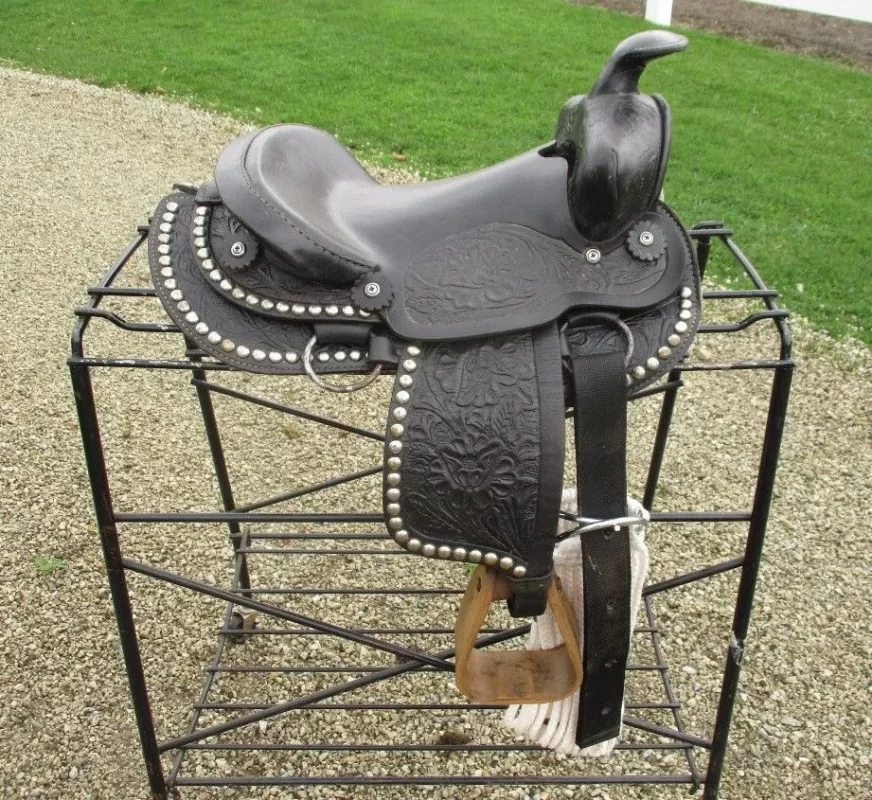Introduction
A Western saddle isn’t just an accessory; it’s a vital piece of equipment for riders in rodeo events, cattle ranching, and trail riding. They are designed for long hours in the saddle, offering comfort and stability. However, a new Western saddle can be quite an investment. This is where used Western saddles come into play, offering an affordable and dependable alternative.
The Rich History of Western Saddles
The Western saddle is an iconic symbol of the American frontier. It’s a result of the fusion of Spanish, Mexican, and Native American saddle-making traditions, culminating in a uniquely American design. Western saddles are renowned for their comfort during extended rides, making them ideal for cattle ranching, trail riding, and rodeo events.
Why Opt for Used Western Saddles
Purchasing a used Western saddle can be a wise decision for several reasons:
- Affordability: New Western saddles can be costly, while used ones often provide excellent value for money.
- Quality: Saddles, especially those from reputable brands, are built to last. A well-maintained used saddle can offer years of dependable service.
- Character: Used saddles often come with a history and unique character that new ones lack. They may have interesting stories or be expertly crafted.
What to Look for When Buying Used
When searching for a used Western saddle, consider the following factors:
- Condition: Inspect the saddle for signs of wear, including worn leather, loose or missing stitching, and structural issues.
- Tree Size: Ensure the saddle tree fits your horse properly. An ill-fitting saddle can cause discomfort and health issues for your horse.
- Seat Size: The saddle should fit the rider comfortably, with enough room to move but without being too loose.
- Style and Purpose: Consider your riding discipline and choose a saddle style that suits your needs, whether it’s a roping saddle, barrel racing saddle, or trail saddle.
- Brand and Reputation: Some saddle makers have earned a reputation for quality and durability. Research the brand before making a purchase.
Common Styles of Western Saddles and Their Features
| Saddle Type | Primary Purpose | Key Features |
| Trail Saddles | Comfort on long rides | Deep seat, padded design, multiple attachment points |
| Roping Saddles | Rodeo roping events | Strong horn, secure seat |
| Barrel Racing Saddles | High-speed maneuvers | Lighter design, high cantle for stability |
| Reining Saddles | Precision in reining | Designed for precise communication with the horse |
| Cutting Saddles | Cattle cutting competitions | Close contact feel, freedom of movement for the horse |
| Working Cowhorse Saddles | Ranch work & penning | Balance between durability and maneuverability |
These saddle types cater to various riding disciplines, ensuring that you can find a saddle tailored to your specific needs.
Saddle Fit for Horse and Rider
Ensuring a proper fit for both horse and rider is crucial. A well-fitted saddle is comfortable and safe for both parties. It’s advisable to work with an experienced saddle fitter, especially when buying used. They can help assess the saddle’s fit for your horse and your unique riding style.
Where to Find Used Western Saddles
- Local Tack Shops: Local equestrian stores may have used saddles available for sale or know of sellers in the area.
- Online Marketplaces: Websites like eBay, Craigslist, and specialty equestrian forums often have listings for used saddles.
- Consignment Shops: Some tack shops offer consignment services, allowing people to sell their used saddles through the store.
- Saddle Resale Websites: Websites dedicated to saddle sales often provide detailed information and images of the saddles they list.
- Word of Mouth: Ask fellow riders, trainers, or horse enthusiasts if they know of anyone selling a saddle that fits your criteria.
Evaluating the Condition of a Used Saddle
When examining a used saddle, pay attention to these aspects:
- Leather Condition: Look for cracks, dryness, or excessive wear. Aged leather can still be serviceable if well-maintained.
- Stitching: Ensure all stitching is intact. Loose or broken stitches can indicate structural issues.
- Tree Integrity: Check the saddle’s tree for cracks or damage. A damaged tree can affect both horse and rider comfort.
- Fleece and Padding: Assess the condition of the saddle’s fleece or padding. They should provide proper cushioning and protection.
- Hardware: Ensure that all hardware, including conchos and buckles, is in working condition.
Price Ranges for Used Saddles
The price of used Western saddles can vary widely depending on factors like brand, condition, rarity, and the region. As of my last update, here’s a general price range:
- Budget Range: $100 – $500
- Mid-Range: $500 – $1,000
- High-End: $1,000 – $3,000+
- Collectible and Antique: $3,000 and up
Keep in mind that these are general guidelines, and prices can fluctuate based on market conditions.
Caring for Your Used Western Saddle
Proper care is essential to ensure the longevity of your used saddle:
- Regular Cleaning: Clean your saddle with a leather cleaner and conditioner to prevent cracking and maintain its appearance.
- Storage: Store your saddle in a cool, dry place, away from direct sunlight. Use a saddle cover to protect it from dust.
- Maintenance: Inspect your saddle regularly for signs of wear and address any issues promptly to prevent further damage.
- Re-Flocking: If your saddle has wool flocking, consider re-flocking it as needed to maintain proper padding.
- Oiling: Periodically oil the saddle to keep the leather supple and prevent drying.
Conclusion
Used Western saddles offer an excellent opportunity for riders to own a reliable and character-filled piece of equipment without breaking the bank. When searching for the perfect saddle, remember to consider factors such as fit, condition, and style. Your saddle, whether it’s for trail riding or competitive rodeo events, should be a trusty companion on your equestrian journey. Happy riding!


